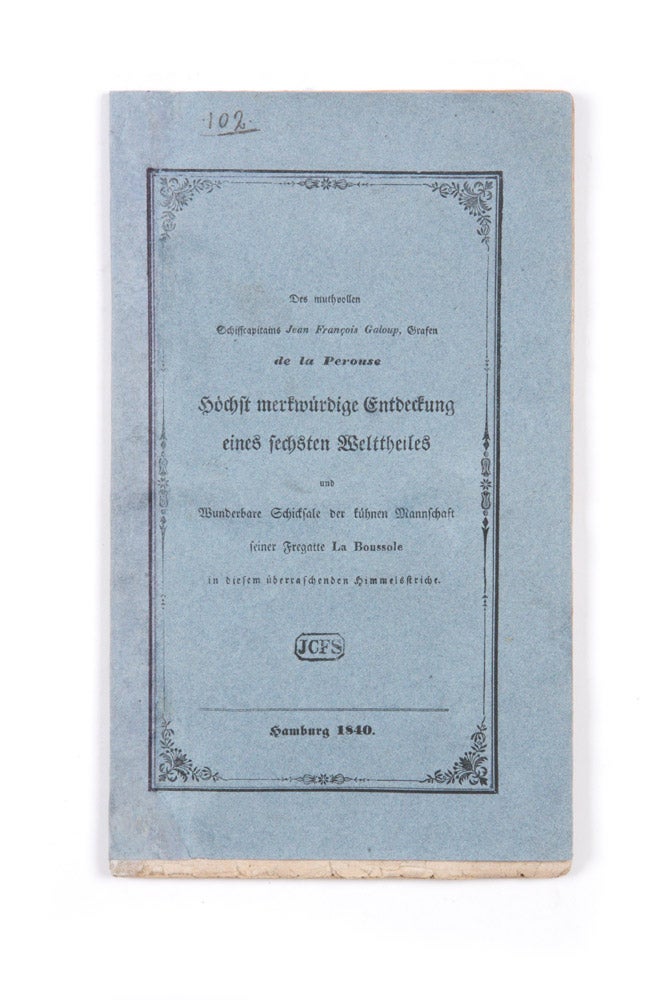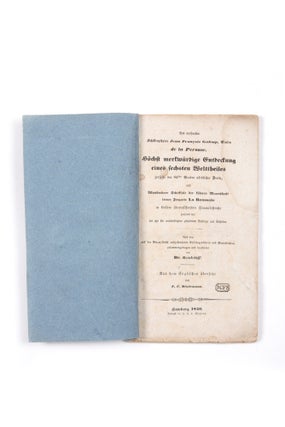Des muthvollen Schiffcaptains Jean Francois Galoup, Grafen de la Perouse…
Des muthvollen Schiffcapitains Jean Francois Galoup, Grafen de la Perouse, höchst merkwürdige Entdeckung eines sechsten Welttheiles jenseits des 85sten Grades nördlicher Breite, und Wunderbare Schicksale der kühnen Mannschaft seiner Fregatte La Boussole in diesem überraschenden Himmelsstriche jenseits der bis jetzt für unübersteigbar gehaltenen Eisberge und Eisfelder. Aus den auf der Bricer-Insel aufgefundenen Reisetagebüchern und Manuscripten zusammengetragen und bearbeitet von Dr. Reidcliff. Aus dem Englischen übersetzt von F.C. Bindemann.
Hamburg: J.G.Sn. Wichers, 1840.
Octavo, 64pp; original printed dark blue wrappers; protective cloth case.
One of the most bizarre and rarest of La Pérouse fantasies
Very rare: a gripping and romantic account of the survival of La Pérouse, describing his voyage into the far reaches of the Arctic, through the Bering Strait and turning north-east to the Pole, where he discovers a sunlit society ruled by women in this remote but beautiful 'New France.'
Very rare: a gripping and romantic account of the survival of La Pérouse, describing his voyage into the far reaches of the Arctic, through the Bering Strait and turning north-east to the Pole, where he discovers a sunlit society ruled by women in this remote but beautiful 'New France.'
The story is said to be based on the discovery of a pile of manuscripts on remote "Bricer Island" by an English doctor called Reidcliff, which recount in some detail the survival of La Pérouse and his escape from Vanikoro on La Boussole and his decision – rather under-explained – to sail up into the Arctic, where he abandons ship to continue into ever higher latitudes on foot. He and his crew are rewarded for their ardour by discovering a sunny paradise. The novel is therefore one of the most curious of La Pérouse fictions, the only major one published after the discoveries of Peter Dillon and the French explorer Dumont d'Urville in the late 1820s had finally solved the riddle of his disappearance.
The so-called "translator" Bindemann is considered to have been the likely author: little is known about him. The book has been compared with Swift's Gulliver's Travels, no surprises there, but Gersdorf (in Repertorium der gesammten deutschen Literatur) has also more usefully pointed out similarities with Herschel's supposed moon discoveries (The "Great Moon Hoax" stories appeared in a series of articles in 1835). There are also references, for example, to places like Melville Island, reconnoitred by Sir William Parry in 1819, which points to the up-to-date geographical accuracy underpinning the whole book.
There are convincing records for just two editions of this work, a provincial edition published in the small town of Hanau (near Frankfurt am Main) in 1837 with a different title, and this Hamburg edition of 1840. Both are very rare.
An extremely rare La Pérouse fantasy, written in the best tradition of imaginary voyages, and following on from a number of fanciful narratives sparked by the mysterious disappearance of the French voyage. This fantasy actually appeared after Dillon's chance discovery of relics of the La Pérouse expedition on Vanikoro in 1826, news of which had been widely publicised by 1830: this odd book was thus very late in the genre. As so often with imaginary voyages, there is an overt framing device in the form of the "famous" English physician Reidcliff's discovery of French manuscripts.
"One of the more bizarre La Pérouse fantasies, [it] is allegedly based on the journal and manuscripts found by an Englishman, Dr Reidcliff, on 'Bricer Island' in 1835. The papers prove that the Boussole managed to sail away from Vanikoro, passing through the Bering Strait as far north as 82ºN where it was stopped by ice. La Pérouse then went on foot over the ice until, between 85º and 88ºN, he discovered a sunny paradise, full of fruit-tree orchards and unknown animals, in a land ruled over entirely by women. The sailors can find nothing more enticing, although they are always at risk of being taken by enormous cranes that transport their unsuspecting victims into an icy realm. Reidcliff discovers the papers of the expedition under mysterious circumstances, and transmits them to Europe…" (Howgego). Naturally, the protagonists have named their newly discovered sixth continent New France.
The acknowledged "translator" Bindemann is almost certainly the author of the piece. It has been suggested that the jokey name of Dr Reidcliff could deliberately allude to the gothic novels of Ann Radcliffe (1764-1823). The book has been compared with Swift's Gulliver's Travels, no surprises there, but Gersdorf (in Repertorium der gesammten deutschen Literatur) has also more usefully pointed out similarities with Herschel's supposed moon discoveries (The "Great Moon Hoax" stories appeared in a series of articles in 1835).
There were either two or three editions of the work, which first appeared under a different title (Letzte Schicksale und entedeckungen des franz. Schiffscaptains Grafen de La Perouse…) in Hanau in 1837. This ran to 240 pp. but in its present Hamburg 1840 edition it has been reduced to 64 pp. by setting in very small type.
The book was known to Ferguson only from the entries for the 1837 Hanau edition and this 1840 Hamburg version in Edward Weber Allen's Jean François Galaup De Lapérouse: A Check List (San Francisco, 1941). No copies of any edition were located for the Ferguson Addenda. It seems that the La Pérouse bibliographer McLaren, working from the same details, has confused the issue by adding an 1840 Hanau edition (also said to run to 64 pp., but with title matching the 1837 version), for which he cites only an Allen copy. There is no such copy in the Allen collection (now in the University of Washington library in Seattle) but the Allen copy of the present Hamburg 1840 edition with different title, which is indeed in the Allen Library today, is not cited by McLaren. McLaren does however locate a copy of the present edition in the Mitchell Library, State Library of New South Wales. We have also located a copy in the Turnbull Library in New Zealand. Apparently no other copy of any version is held in Australia or New Zealand even now.
(To confuse things further, WorldCat does cite one German library holding of a supposed 1840 Hanau edition, but the details are so sketchy that we believe this to have been another confusion between the two actual editions. The McLaren ghost entry and this WorldCat entry do not match.)
In short we believe that there were just two editions: Hanau 1837 and the present Hamburg 1840 publication, both of which are very rare outside German library holdings.
Ray Howgego has identified eight strands of La Pérouse fiction, of which this is the last (L17, see also L9 for summary and L10-L17 in Encyclopedia of Exploration [vol 5]: Invented and Apocryphal Narratives of Travel, Hordern House, 2013).
Ferguson, 3026 (and see 2291 for the earlier edition); Howgego, Vol 5 Imaginary Voyages, L17; Centenaire de la mort de Laperouse, Paris, Société de géographie, 1888: p. 193, no 207; McLaren, 739 (and 736-7).
Condition Report: Some light staining throughout but essentially in good condition; the original wrappered binding is in good state having been preserved by a plain paper cover since discarded.
Price (AUD): $3,850.00
US$2,514.29 Other currencies



